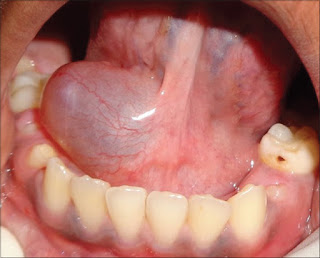Recognizing a Ranula
What is ranula?
Ranulas are clear or bluish cysts caused by a blocked salivary gland in the mouth. These slow-growing benign growths are found on the floor of the mouth and can vary in size. Some cysts remain small, whereas others enlarge and cause problems.
A clear or bluish translucent growth on the floor of the mouth is the main symptom of a ranula. They don’t typically cause pain, so you may not notice it until the cyst increases in size.
If you have a simple ranula, swelling is confined to the sublingual gland. This is the smallest of the three paired salivary glands around the throat and mouth.
Another type of ranula is a diving or plunging ranula, which occurs when a simple ranula ruptures. The rupture triggers the formation of a pseudocyst that extends into the neck through a defect of the mylohyoid muscle, which is a group of neck muscles that control the tongue. This causes a mass in the submandibular space (the facial space of the head and neck).
A plunging ranula can produce additional symptoms, such as difficulty swallowing, difficulty speaking, and tracheal compression.
Sometimes, the cause of a ranula is unknown and the swelling occurs spontaneously. In other cases, ranulas occur after trauma to the floor of the mouth (like an oral surgery).
An injury can damage the ducts that move saliva from the salivary gland into the mouth, causing a blockage. When saliva can’t properly drain, it accumulates in the gland and forms a dome-shaped cyst. Trauma can include biting the lower lip or cheek or getting hit in the face.
Plunging or diving ranulas are caused by a rapidly growing simple ranula that ruptures.
A small ranula that causes no symptoms may not require a visit to your doctor. But you should see a doctor for an enlarged ranula since there’s the risk of the lesion rupturing. You’ll know the ranula is enlarged if it impairs eating, swallowing, speech, or breathing.
Some doctors can make a diagnosis based on the appearance and location of the cyst. Your doctor may order image tests to examine the extent of the swelling or to confirm that your symptoms are caused by a ranula.
Imaging tests to diagnose a ranula include:
- a CT scan, which uses a combination of X-rays to take detailed pictures of the inside of the body
- an MRI, which uses strong magnets and radio frequency waves to produce images of the body
- an ultrasound of your neck, which uses sound waves to create images inside of the body
These tests can also distinguish a ranula from conditions with similar symptoms and features, such as an abscess, a dermoid cyst, or a branchial cleft cyst.
Small ranulas that don’t cause problems may not require treatment. Some cysts disappear on their own. But treatment is necessary for enlarged ranulas, especially when swelling interferes with swallowing or speaking.
Depending on its size, your doctor can make an incision and drain the cyst to decrease swelling. Even if this treatment works, fluid may accumulate again.
Surgery is effective for larger ranulas. This involves removal of the cyst and the parent sublingual gland. Removing the cyst alone may not resolve the issue since the problem originates in the gland. If your doctor preserves the gland, a new cyst may develop.
Another treatment option for a ranula is marsupialization. This is when your doctor cuts a slit in the cyst and sutures the edges. This procedure allows the cysts to drain freely.
If you experience pain, your doctor may recommend an intralesional steroid injection into the skin beneath the cyst. This not only improves the appearance of the cyst — it may also reduce painful symptoms.
Home treatments
One study found that gamma-linolenic acid (oil of primrose) may also be used. This natural remedy contains omega-6 fatty acids, which help reduce inflammation. Talk to your doctor before using oil of primrose.
Complications associated with an enlarged ranula include rupture as well as difficulty swallowing and speaking. Recurrence is a possibility after draining a cyst.
There are also complications associated with surgery. These include temporary tongue numbness after surgery, post-surgery hematoma, and infection. Signs of infection include fever, chills, and pain. See a doctor if you have signs of infection.
A simple, small ranula is usually minor and resolves itself without treatment. Larger ranulas can be more complicated, but with treatment the outlook is generally positive. Surgery to remove the cyst and the sublingual gland may produce the best outcome.
There are currently no known ways to prevent a ranula.



Comments
Post a Comment